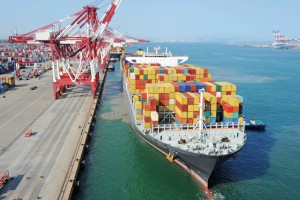Share This
Related Posts
Tags
Ports of Tomorrow
By Erica Rascón on Jun 8, 2016 in News
More than 95 percent of trade worldwide is moved via water. Thoug h the share of maritime trade has not decreased in recent years, its sluggish growth has shipping lines competing for network efficiency. Current growth lingers between 2-3 percent, compared with 10-12 percent before 2008.
h the share of maritime trade has not decreased in recent years, its sluggish growth has shipping lines competing for network efficiency. Current growth lingers between 2-3 percent, compared with 10-12 percent before 2008.
Kim Fejfer, CEO of APM Terminals, explains, “The need for change has been more pronounced in the past two years than in the past 20 years,” he says. “Changes in shipping require not only investment and increased efficiency at the individual port level, but the configuration of port complexes needs to adapt to cope with current trade flows, increased ship sizes and demands for lowest possible costs. There will be clear winners and losers in the coming years.”
To emerge as victors, best practices suggest packing more products onto fewer, larger ships. This method decreases transportation and personnel costs on one end. On the other, ports must now undergo costly renovations and technological upgrades to accommodate the larger vessels and greater loads:
Updates to Ports
In the Port of Oakland, Ben E. Nutter Terminal recently reconfigured entrance gates, added more than 100 units of equipment to expedite cargo handling, and upgrading the terminal operating system. Upon reopening this spring, the terminal receives empty containers and export cargo with the inbound call of the 1,100 TEU vessel, Ever Liberal.
At Port of Baltimore, Ports America Chesapeake and CSX Intermodal signed an agreement that gives the former company operational responsibility for the intermodal container service. This agreement will promote smoother operations for direct on-dock access to rail service. It will also improve the port’s appeal as one of only three East Coast ports capable of accommodating super-post-Panamax ships.
The Port of Houston Authority receives 67 percent of all containerized cargo in the Gulf. To improve operations, Port of Houston Authority recently implemented the Navis N4 terminal operating system. The port will also redevelop 20 acres of Barbours Cut for container stacking, as well as four new SPP cranes, and a 1,300-foot dock renovation.
The Savannah Harbor expansion project will increase the maximum draft of vessels to 47 feet at mean low water. The controversial project is a direct anticipation of the completion of the Panama Canal expansion, which will accommodate ships with a maximum draft of 50 feet.
Looking Forward
Deepening harbors, redesigning docks, and upgrading software are only the first stages of meeting the changing needs of the industry. American ports are some of the most technologically antiquated in the world.
Port automation has become a standard in other developed nations around the world. In Europe, debates over the advantages of fully automated ports are already on the table.
In an interview with World Maritime News, Torben Seebold, ETF Dockers’ Section vice-chair, explains that fully automated ports may not be the best long-term solution.
“We believe that there is a need to carefully consider broader issues: are benefits from building and running fully automated terminals higher than their costs?” says Seebold. “Next, when taking decisions on building fully automated terminals, it should be considered that all the jobs that are lost are translated into lower taxes for the port cities and regions and for the state as a whole. Who’s going to pay for the infrastructure then? We should also ask ourselves if it is meaningful to invest in activities that do not generate jobs. Does it make sense to make huge investments if these are not translated into more welfare and employment?”
Terje Samuelsen, ETF Dockers’ Section Chair adds, “Ports with less workers or without workers are not necessarily smarter: we have in Europe cases of traditional terminals that are much more efficient and profitable than automated ones.”
The domination of automation has yet to take root at American ports. Yet with the expansion of the Panama Canal underway, a new series of efficiency upgrades may follow in its wake.
